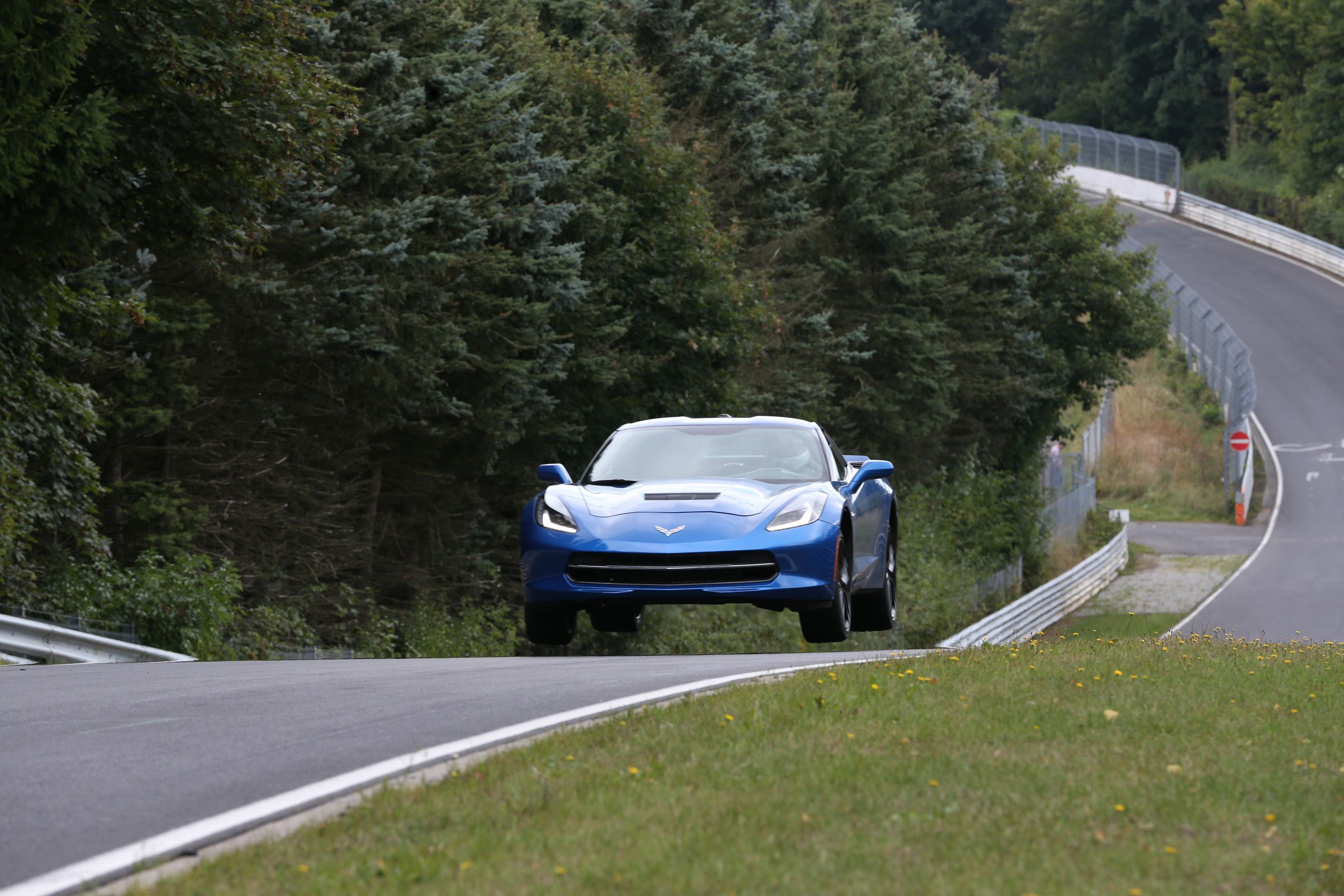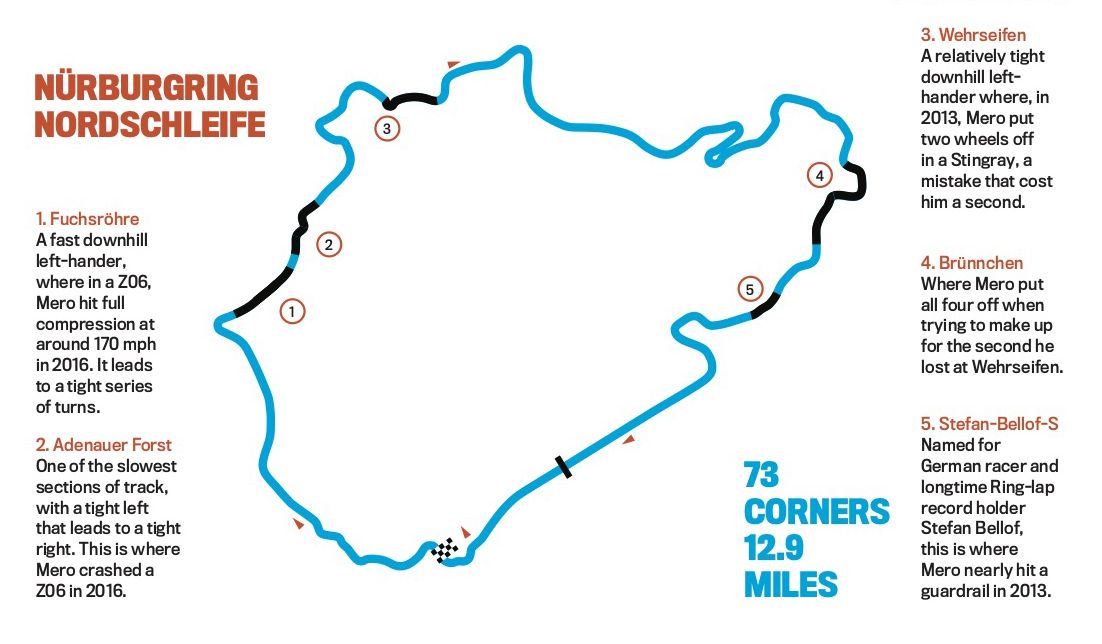The Cursed Corvette

TIM MCDONAGH
Chevy wanted the seventh-generation Corvette to set a Nürburgring lap time. Five years of bad luck got in the way.
Jim Mero wants you to know how quick the C7 Corvette was at the Nürburgring. He wants you to know how hard he and his team tried to get the car to turn a sub-seven-minute lap at the famous 12.9-mile German track, and how the universe had other plans.
In 2008, Mero ran a C6 Corvette—the sixth generation of Chevrolet’s iconic sports car, in 638-hp ZR1 form—around the Ring in 7 minutes, 26.4 seconds. The video of that lap went viral, kicking off America’s obsession with Ring lap times.
Over the C6’s nearly decade-long life, Mero returned to the Nürburgring and set ever-quicker lap times in the Z06 and ZR1. But from 2013 to 2018, we never saw an official lap time or video for the seventh-generation Corvette. Why not? Corvettes were seen constantly at the track. What went wrong? Mero says the truth wasn’t a conspiracy, as some have suggested; it was a curse. And now that a mid-engine Corvette is on the horizon and the C7’s life is coming to an end, he wants to set the record straight.
-----------
Jim Mero: We went with the Stingray Z51 in 2013, and we had scheduled eight attempts at a lap. Every one of them either got rained or fogged out. As a matter of fact, do you remember the Z/28 video where Adam [Dean, a Camaro development driver] finished his lap in the rain?
Road & Track: Of course.
JM: I was three minutes behind him. Within five seconds, through the Stefan Bellof esses, it went from perfectly dry to almost putting me into the guardrail. Our objective was to beat the [991-generation Porsche 911] Carrera S, which did a 7:37.9. Back then, the fast-lap opportunity was the last lap of the day, and [the track] gave each company who requested it one lap a week.
R&T: But those chances were rained out.
JM: Yep. But somebody canceled on a Friday, so it was last lap, last day, last everything. No pressure. I got a little overanxious… I mean, I was hauling ass right up until I got through Wehrseifen. I dropped two wheels there and then made the mortal sin of thinking, "Now I have, what, maybe four or five minutes to make up that second I just lost?" I started overdriving the car. At Brünnchen, I put all four off, and I lost another two seconds.
JM: I tried to convince them, and they just decided to punt.

Mero and the C7 Stingray catching some air at the Nurburgring.
CHEVROLET
R&T: You went back to Germany the next fall with a Z06. What happened?
JM: The fall is the wrong time to be there. There are times the dew point is so low, it won’t rain for a week and the track will still be half wet.
R&T: That’s when you crashed, right?
JM: Yeah. It was our first day with the Z06 on the Nürburgring. We had just started dialing in the MagneRide calibration. After that, I overlaid the data of the lap before [the crash] on top of that of the next lap, and I didn’t do anything different. All we could surmise was something got spilled on the track between the two laps.
R&T: That was that for 2014. You went back in spring of 2015 with another Z06.
JM: We just said, “Let’s put the 100-octane calibration in the car and see where we’re at.” That’s when we ran a 7:10.
R&T: Why was that time never publicized?
JM: Because we didn’t have this 100-octane calibration available for sale at that time—it still needed to be validated. They didn’t want to go forward with the lap.
R&T: But that calibration was eventually offered to the public. Why not show off the lap then?
JM: A marketing guy said, “Oh, nobody cares about it.” They said, “They’re going to want to know how the car ran without the 100-octane cal.” I said, “They’ll never know that, because we never ran it.” Unfortunately, at that point, it was like talking to a wall.

TIM MCDONAGH
R&T: Then another crash in 2016. What happened there?
JM: We were excited because we had a Z06 with a new supercharger lid. With the
Z06, I always ran with everything off, no Performance Traction Management, just ABS. I could put different track calibrations in all three [drive] modes and switch between them. I put it in Sport—and this happens once every thousand times—it went to, I think, Eco or Weather. What I didn’t know is, when that happens, it turns everything back on.
I came up on Fuchsröhre, where you’re going downhill and you compress the car at the bottom at about 170 mph, then you come up the hill and you have a hard left to Adenauer Forst. Well, I come down, I hit the brakes, and I’m trying to turn, and the car’s just going straight, which is what it’s supposed to do in Street mode. I came off the brakes, made the
turn, and then there’s another very tight right-hander. I just went straight and hit the guardrail.
We had a manual-transmission Grand Sport there that we were just doing some tuning on. We never had the intention of running lap times with it, but we pulled it out because we had the last lap of the day scheduled, and now we didn’t have a Z06.
R&T: What happened with that car?
JM: We ran a 7:27. We had these little Sony Handycams that we bought for all the C6 stuff. We put them in but forgot to turn on the power supply. They only recorded the warm-up lap.
R&T: But the car had a backup for video—Chevy’s Performance Data Recorder.
JM: Two turns from the end—I’ve seen this happen two times—the PDR video froze, but the audio kept running, and the elapsed time kept running. All the data shows a 7:27, but because the video froze for a couple of seconds, GM didn’t want to post that.

R&T ILLUSTRATION
R&T: What about the ZR1?
JM: That was probably the biggest disappointment. The Nürburgring changed its protocol. They said, “We’re going to set this two-hour block on Wednesday from 5:30 to 7:30 and split the cost among the number of manufacturers that want to participate.”
We were expecting to go up to the paddock where we normally go, everybody gets a warm-up lap, everybody gets a hot lap. One hour before we’re running, we heard there would be no warm-up laps, and we’d have to go into the track where the public goes, which is probably three-quarters of the way down the last straightaway. And we’d have to run a bus-stop chicane at the start line.
R&T: Which meant cold tires?
JM: Yeah. We have tire warmers, but in order to properly warm a tire, you have to have them warming for three to four hours at about 150 degrees. An hour before you go out, you crank them up to 200.
R&T: How did the car change with cold rubber?
JM: I only had 0.9 mile and two turns to do the best I could to heat the tires. I’ll say it’s one of the ballsiest laps I’ve ever driven, because I knew I had shit balance, shit grip, everything, and I still went for it. It was pure reacting to the car. A hundred hours of
looking at data and knowing every spot on the track to pick up the throttle, be wide open, all went out the window. Officially, we did a 7:05, but I take 1.2 seconds off for the chicane, so call it a 7:04.

A C7 ZR1 prototype attacking the Ring in 2018
BRIAN WILLIAMS/SPIEDBILDE
The next day, Mero’s last on the Nürburgring as a GM employee, he had the opportunity to set a time in a ZR1. A cooling-system issue kept sending the preproduction car into engine-protection mode. Despite the efforts of two Corvette technicians on the ground, there wasn’t enough time to fix it. As a result, the car produced something on the order of 625 hp—nowhere near the standard 755.
Mero ran fast regardless—a 7:06. But he wanted a lap under seven minutes. The data indicated that the time was within reach, and that benchmark would put the ZR1 ahead of the Dodge Viper ACR, making it the quickest American car around the circuit. Mero even tried to postpone his retirement by a few weeks, chasing the opportunity to run the ZR1 one more time. But it wasn’t meant to be.
Nürburgring lap times are a gold standard among car enthusiasts, a data point that demonstrates a car’s ability and approachability more than any other metric. To set a quick Ring time, you need a great car and a great driver, but neither matter without luck. Mero and the C7 didn’t have any.
“Just because we never came up with anything, [the C7] is getting a bad rap, and it doesn’t deserve it,” he says. “It’s personal. Not because I want any kind of recognition, but because I want to show the world—or at least the C7 customer—that this car rocks.
“It’s the best thing we’ve ever done. Call it a series of unfortunate events, man. You couldn’t make this stuff up.”
SOURCE: Road & Track